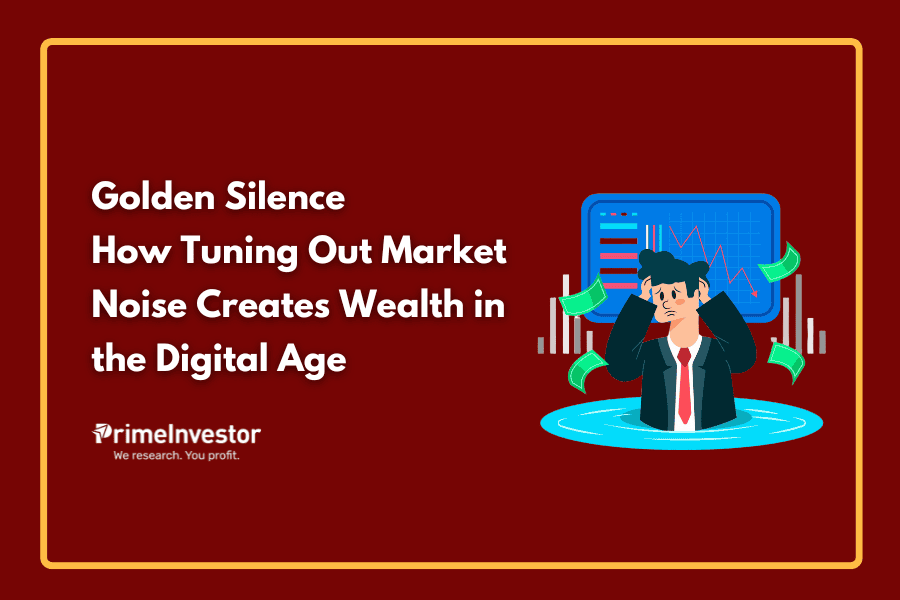When I started out as a stock investor in the mid-90s, the biggest challenge was the lack of information on companies, sectors and markets. Companies declared results once in six months and held no conference calls. Annual reports were cryptic and published 9-12 months after the financial year. Brokerages and institutions, if they wrote research reports, kept it to themselves.

My knowledge of macros and the global economy was restricted to the few articles I read in financial magazines many days after they were published. I never thought they had anything to do with my portfolio.
In retrospect, those were golden days for the stock market investor, because you knew only the essentials!
Information overload
The challenge for today’s equity investors is the opposite. They are deluged 24/7 by a tidal wave of information from the social and mainstream media and need to wade through it while making their investing decisions.
The anxiety that this information overload creates is evident from the queries we get from folks as markets tumble. Sample these:
- Do we think the US is headed for recession? If the US slips into recession, will the Fed cut rates? Will this be good or bad for FII flows into Inda?
- What does it mean for Gold ETFs if US’ Fort Knox really doesn’t have gold?
- Are we in for a new world order where valuations won’t work, like Kotak says?
- Is Shankar Sharma right when he wrote that retail investors were foolish to buy equities when FIIs sold?
- Should we listen to Naren and sell all small/mid-caps?
It’s not just direct stock investors but also mutual fund investors who seem to be losing sleep over all this.
Rather than answer these queries individually, let me attempt a hold-all answer.
- As an equity investor, you can safely afford to ignore 99% of the information coming at you from social and mainstream media.
- You need to focus only on news or interviews directly impacting the earnings of companies you own or plan to own.
- Macro forecasts are rarely useful, and expert views have vested interests.
In this era of information overload, knowing what to ignore is the secret to successful investing. Let’s see what you can safely ignore.
Macro chatter doesn’t matter
One of the impressions created by media today is that to be a successful stock investor, you need to be able to decipher what macro events and geopolitical conflicts in far corners of the world mean. Nothing could be farther from the truth.
Tune into X today and your feed is overflowing with debates on whether Trump/Musk policies will on a US recession, what the end of NATO will mean for Europe, what China’s AI experiments mean for the Mag 7 stocks and so on.
While all this may be useful to track for Foreign Institutional Investors (FIIs) who make cross-country calls, it is irrelevant to investors like us who plan to allocate 90% to 100% of our equity portfolio to Indian stocks and perhaps put 10% in an international index.
When market gurus give erudite interviews and brokerages put out 100-page reports on how Indian stocks will be affected by Fed rate cuts, US recession, Trump tariffs, FPI flows et al they are just making educated guesses, that could easily be wrong. This is equally true of geopolitical conflicts where hardly anyone knows what will play out.
To rewind a bit, when Russia-Ukraine hostilities broke out in 2022 and the Israel-Hamas conflict in 2023, some X experts were sure that we are on the brink of World War III and risked nuclear annihilation. The Greek debt crisis, the collapse of Silicon Valley Bank and the Evergrande crisis in China were all said to herald the collapse of the global financial system. The 9/11 attack on the World Trade Center and the advent of Covid were supposed to usher in a ‘new world order’.
You may not even remember some of these world-changing events today. But you do know that investors who bought into Nifty50 during those events made a ton of money.
A second reason why there’s no point fretting over macro events is that there is only a tenuous correlation between GDP and stock markets. There are published studies to show this. The relationship between macro variables such as interest rates, currency moves and inflation with FII flows and stock prices is even harder to quantify.
Between 2003 and 2010, the Indian stock market enjoyed a stellar bull run despite double-digit inflation and rising rates. Covid took an enormous toll on the economy and families, yet Nifty earnings trebled between April 2020 and September 2024. If anyone had been asked to predict how the economy or markets would fare in April 2020, no one could have told you that the rebound would be so quick.
Third, even folks who call themselves experts are often talking through their hat. In a pithy memo in 2021, Howard Marks, a doyen of market cycles, explained why he gives no weight to macro forecasts in investing. He argued that if a macro view is the consensus (like the US recession being imminent), it is already factored into stock prices. If someone makes an outlandish macro call that is far removed from consensus, they are often wrong. Therefore, there is really no money to be made positioning for macro events.
Marks shared this quote from Daniel Boorstin in his memo- “The greatest enemy of knowledge is not ignorance, it is the illusion of knowledge.”
Waiting for macros or geopolitical risks to ‘blow over’ before investing is counter-productive, because when the dust settles, the bargains are gone (another one from Marks). In a thriving economy like India, it is only in times of high macro uncertainty or conflict that you get entry points into stocks at cheap valuations.
Beware of biases
But if there’s one set of experts who make macro forecasters look good, it is market mavens who give out media interviews and sound-bytes on which way the market will head. Scrolling through my Google feed recently, I found three attention-grabbing news articles on Indian markets.
- One was on a ‘scenario-building’ report from Morgan Stanley. It did a lot of modelling to conclude that based on what happened with tariffs etc, the Sensex could either shoot up to 1,05,000 or tumble to 70,000 by December 2025. You wouldn’t worry too much about this wide range, if you knew how their previous Sensex targets have fared.
- A second was a mystifying write-up from a Kotak Institutional report which told us that we all needed to “discard our old valuation framework and heuristics-based investment framework” due to the arrival of a new and uncertain world order. This made me wonder a bit what kind of equity investing framework one would have left, after disregarding valuations and numbers.
- A third was an interview from a perpetually angry market veteran who said that retail investors had been fools to buy into equities when FIIs had been exiting, and that the current market situation reminded him of the scam year of 1992 after which Indian stock investors made no money for 10 years. But then, Indian investors did make money in the bull run of 1993-94 and again in the dotcom boom from 1996 to 1999.
- A fourth was an article quoting Robert Kiyosaki (author of Rich Dad Poor Dad) tweeting that “The everything bubble is bursting. This crash is going to be bigger than the Great Depression of 1929”. However, as this was followed by Kiyosaki asking us not to panic and to “take deep breaths”, while looking for “great assets on sale” the message wasn’t as deep as the headline suggested.
Given how social media algorithms work, you cannot avoid getting your feed littered with such misleading sound-bytes if you follow markets. But to be able to buy when others are fearful as Buffett advised, you need to be able to see through such noise and ignore it.
In my experience, it is best to assume that any brokerage research report, media interview or social media post on markets or stocks is biased. The bias could come from any one of the following:
- The brokerage or institution is probably sitting on client positions which it is trying to defend. It may also be trying to fan the fire of over-optimism or panic in the markets, so that it add to or trim proprietary or client positions.
- The institution putting out the report could be a lead manager or investment banker trying to push through an IPO, offer for sale, QIP or other deal on behalf of a company.
- The market guru has personal short or long positions in the markets or in specific stocks, which he or she is trying to plug.
- Needless to say, folks with large following are also paid hefty sums to perpetuate myths in the social media.
Some market veterans may have no personal agenda to push. But their views may carry a long-standing bearish or bullish bias because of their own life experiences.
Jim Rogers, an oft-quoted global commodities trader, has been a long-term bear on stock markets particularly India. Jeremy Grantham, founder of GMO, has been warning of a bubble in US stocks for many years now. Mark Mobius, formerly of Templeton, is a perma-bull on emerging markets and India. Cathy Wood, manager of ARKK fund, for understandable reasons, is a passionate advocate of tech stocks. In India, Naren of ICICI Pru is a contrarian investor who has always been early to exit expensive markets and themes. Many large X handles are crypto holders who are pretty much hoping for mayhem in economies, stocks, bonds, gold or the dollar.
Apart from bias arising from their own positions or experiences, social media is also rife with folk who love attention or are looking to amass followers and engagement. The more outlandish, fear-mongering and controversial their posts, the higher the payoff for such influencers.
How to filter
To avoid stress and confusion that comes from all this unsolicited advice, we need hacks to actively filter out unnecessary market information from our digital feeds. These are some filters I use. You can add your own:
- Mute social media contacts that put out even one promotional, attention-seeking or engagement-farming post.
- Mute posts from anonymous handles and newbie investors.
- Mute entities seen to frequently plug an asset, company or stock.
- Follow only money managers who have a public track record or active investors who figure in shareholding patterns of companies.
- Give weight to the actions of big investors rather than their words. Warren Buffett’s action of sitting on a large cash pile in his portfolio today, is much more important than what he says about tech stocks or the American economy.
- In mainstream media, pay attention only to news or views that directly impact companies you are invested in or are looking to invest in.
You may have read the Mahabharata anecdote about how Guru Dronacharya tested his students’ skill at archery by asking them what they saw, before aiming for a bird on a far-off tree. Most students said they saw the forest, the tree, branches or leaves. Arjuna was the only warrior who demonstrated his skill, with his singular focus on the eye of the bird.
To be a successful investor today, we need to emulate Arjuna. Stop trying to process all the superfluous information flying at you from multiple sources. When markets correct, focus single-mindedly on researching companies or funds you always wanted to own. Make your choices based on performance, earnings prospects and valuation, as nothing else matters in the long run in the world of investing.





35 thoughts on “Golden Silence: How Tuning Out Market Noise Creates Wealth in the Digital Age”
Well written article. Just my thought. “we need to emulate Arjuna” Why do we need to take an example of imaginary character on a research based article?
Because research-based articles also need to be readable and relatable. If I cited Michael Phelps as an example of single minded focus, it wouldn’t be as relatable.
Ha, funny that you mention Phelps! I am that one swimming nerd Phelps fanboy who would actually relate to his example more 🙂
But, I understand that I am the exception here. We have grown up reading the Arjuna story while learning about the importance of focus. In fact, in my team at work, where we have folks from the four directions in India, I am sure everybody would understand the reference even without actually saying the name Arjuna.
🙂 Glad to know. I happened to read about Phelps’ obsessive journey to amass his swimming victories and that’s why recalled him in this context 🙂
Hello Sir, Thanks for your feedback. This article is on investor behaviour/biases. The reference to Arjuna was intended purely as a very easily relatable metaphor to the Indian audienace (who we cater to) – similar to how western business articles might reference figures like Odysseus or Robin Hood to illustrate concepts. The Mahabharata contains numerous lessons about strategy and decision-making that transcend religious interpretation, much like how Aesop’s fables or Greek mythology are used in Western business literature. Such comment/complaint reveals more about the reader than the writer. Thanks, Vidya
Hi Vidya,
Would the team consider writing a (series of) articles about the lessons about strategy and decision-making? I will be interested in reading and learning if you do, and not just from the Mahabharata, but the Western references too.
Think you should read Mckinsey’s reports and books. They are better placed to give lessons on ‘strategy and decision making’ – quoting both from the East and West. We will share inevstment lessons as we learn 🙂 Thanks Vidya
Well timed article, a need of the hour. Too much noise surrounding Trump’s tantrums, AI and Deepseek etc etc. which makes it all confusing which can lead to ill-timed investment decision making. Your emphasis on “Focusing” on companies that we have invested in or wish to invest is of utmost relevance and importance
Thank you. Have learnt it the hard way! 🙂
Dear Aaarti,
Excellent and timely article. Thanks to you and the entire PI team.
Rajiv
Thank you!
What is the future of holding companies stocks. Sebi had directed in 2024 to these companies to go for auction and also published a first list of few companies to execute it. But then after no second list came and all holding companies and even SEBI are silent on this.
Can you please guide whether one shall buy or hold holding companies stocks at present discounted price compared to their share holdings in big companies?
Not really relevant to this article. But holdco discounts widen in bear markets and shrink in last leg of bull mkt. Hard to give advice on holdcos as universe as call depends on underlying subsidiaries.
“holdco discounts widen in bear markets and shrink in last leg of bull mkt.”
Do holdco fall more in a bear markets than the subsidiaries?
Or is it because the investors ignore the holdco in a bear market and remember them as more options to buy when things are going good?
The second reason. In bear markets there are better options to buy than holdcos
A sane advice; a bugle call. Thanks.
🙏
Nice article makes me remind of a quote— Most time is wasted, because it’s spent in anticipation of something in the future, rather than doing the thing in hand—
🙂 There is actually a Peter Lynch quote : More money is lost waiting for a correction than being in one!!
This is a timely article and a clear message to investors, especially the ones who entered the post-COVID era.
Thank you!
Thank you Aarati Ji, for sharing your expertise and offering a beacon of clarity in the often-chaotic financial landscape!
Thank you. My pleasure
Aarati, What an excellent article ! It is precisely for this I subscribed to PrimeInvestor. No queries – just appreciation to you and your wonderful team.
Thank you!
super Article Aarati, could feel like i am listening to your podcast.
Regards
Devang
Thanks 🙂
Comments are closed.